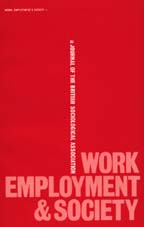Crossref Citations
This article has been cited by the following publications. This list is generated based on data provided by
Crossref.
Ward, Kevin
2003.
UK Temporary Staffing: Industry Structure and Evolutionary Dynamics.
Environment and Planning A: Economy and Space,
Vol. 35,
Issue. 5,
p.
889.
Heery, Edmund
2004.
The trade union response to agency labour in Britain.
Industrial Relations Journal,
Vol. 35,
Issue. 5,
p.
434.
Purcell, John
Purcell, Kate
and
Tailby, Stephanie
2004.
Temporary Work Agencies: Here Today, Gone Tomorrow?.
British Journal of Industrial Relations,
Vol. 42,
Issue. 4,
p.
705.
Druker, Janet
and
Stanworth, Celia
2004.
Mutual expectations: a study of the three‐way relationship between employment agencies, their client organisations and white‐collar agency ‘temps’.
Industrial Relations Journal,
Vol. 35,
Issue. 1,
p.
58.
Ward, Kevin
2005.
Making Manchester `flexible': competition and change in the temporary staffing industry.
Geoforum,
Vol. 36,
Issue. 2,
p.
223.
Freeman, Harris
and
Gonos, George
2005.
REGULATING THE EMPLOYMENT SHARKS: RECONCEPTUALIZING THE LEGAL STATUS OF THE COMMERCIAL TEMP AGENCY.
WorkingUSA,
Vol. 8,
Issue. 3,
p.
293.
Ajayi-Obe, Olufunmilola
and
Parker, Simon C.
2005.
The changing nature of work among the self-employed in the 1990s: Evidence from Britain.
Journal of Labor Research,
Vol. 26,
Issue. 3,
p.
501.
Finegold, David
Levenson, Alec
and
Buren, Mark
2005.
Access to training and its impact on temporary workers.
Human Resource Management Journal,
Vol. 15,
Issue. 2,
p.
66.
Burgess, John
Biggs, David
Burchell, Brendan
and
Millmore, Mike
2006.
The changing world of the temporary worker: the potential HR impact of legislation.
Personnel Review,
Vol. 35,
Issue. 2,
p.
191.
Carey, Malcolm
2006.
Selling social work by the pound? The pros and cons of agency care management.
Practice,
Vol. 18,
Issue. 1,
p.
3.
Mitlacher, Lars W.
2006.
The organization of Human Resource Management in temporary work agencies—towards a comprehensive research agenda on temporary agency work in Germany, the Netherlands and the US.
Human Resource Management Review,
Vol. 16,
Issue. 1,
p.
67.
Burgess, John
Forde, Chris
and
Slater, Gary
2006.
The nature and experience of agency working in Britain.
Personnel Review,
Vol. 35,
Issue. 2,
p.
141.
Carey, M.
2007.
The Order of Chaos: Exploring Agency Care Managers' Construction of Social Order within Fragmented Worlds of State Social Work.
British Journal of Social Work,
Vol. 39,
Issue. 3,
p.
556.
Carey, Malcolm
2007.
White-Collar Proletariat?.
Journal of Social Work,
Vol. 7,
Issue. 1,
p.
93.
Mitlacher, Lars W.
2007.
The Role of Temporary Agency Work in Different Industrial Relations Systems — a Comparison between Germany and the USA.
British Journal of Industrial Relations,
Vol. 45,
Issue. 3,
p.
581.
Evans, Yara
Wills, Jane
Datta, Kavita
Herbert, Jo
McIlwaine, Cathy
and
May, Jon
2007.
'Subcontracting by Stealth' in London's Hotels: Impacts and Implications for Labour Organising.
Just Labour,
Forde, Chris
and
MacKenzie, Robert
2007.
Getting the mix right? The use of labour contract alternatives in UK construction.
Personnel Review,
Vol. 36,
Issue. 4,
p.
549.
Ruyter, Alex de
2007.
Should I stay or should I go? Agency nursing work in the UK.
The International Journal of Human Resource Management,
Vol. 18,
Issue. 9,
p.
1666.
Forde, Chris
MacKenzie, Robert
and
Robinson, Andrew
2008.
Help wanted? Employers' use of temporary agencies in the UK construction industry.
Employee Relations,
Vol. 30,
Issue. 6,
p.
679.
Lai, P.-C.
Soltani, E.
and
Baum, T.
2008.
Distancing flexibility in the hotel industry: the role of employment agencies as labour suppliers.
The International Journal of Human Resource Management,
Vol. 19,
Issue. 1,
p.
132.




